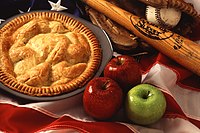California cuisine

| Part of a series on the |
| Culture of California |
|---|
 |
|
California Portal |
| Part of a series on |
| American cuisine |
|---|
 |
California cuisine is a food movement that originated in Northern California. The cuisine focuses on dishes that are driven by local and sustainable ingredients with an attention to seasonality and an emphasis on the bounty of the region.[1][2]
The food is historically chef-driven; Alice Waters's restaurant Chez Panisse is an iconic example. Dishes and meals low in saturated fats and high in fresh vegetables and fruits with lean meats and seafood from the California coast often define the style.
The term "California cuisine" arose as a result of culinary movements in the last decades of the 20th century and is not to be confused with the traditional foods of California. California fusion cuisine has been influenced by French cuisine, American cuisine, Italian cuisine, Mexican cuisine, Chinese cuisine, among other food cultures.
History
[edit]One of the first proponents of using fresh, locally available foods was Helen Evans Brown, who became friends with James Beard after publishing Helen Brown's West Coast Cookbook in 1952. She advocated using fruits and spices available in one's neighborhood, forgoing poor grocery store substitutes, as well as fresh seafood, caught locally.
The book received wide acclaim and became the "template" for what is now thought of as California cuisine.[3] Alice Waters, who opened Chez Panisse restaurant in 1971 in Berkeley, California, has contributed significantly to the concept of California Cuisine.[4][5]
About the same time, in Yountville in the Napa Valley, Sally Schmitt[6] began serving single-menu monthly dinners that emphasized local ingredients, continuing the concept when she and her husband Don opened The French Laundry in 1978.[7]
In Los Angeles, Wolfgang Puck was also an early pioneer of California cuisine; starting with his work at Patrick Terrail's[8] Ma Maison, and further work with Ed LaDou on California-style pizza at Spago and Asian fusion at Chinois on Main.[9]
Mark Peel, who worked for both Waters and Puck, went on to co-found La Brea Bakery and Campanile Restaurant[10] with his then-wife Nancy Silverton. As executive chef, he mentored other up-and-coming chefs. “Campanile has played an important role in shaping the cuisine of Southern California and beyond, not just through its menu but also through the many graduates of its kitchen.”[11]
Daniel Patterson, a more modern proponent of the style,[12] emphasizes vegetables and foraged foods while maintaining the traditional emphasis on local foods and presentation.[13]
California-style pizza was popularized by Alice Waters, Ed LaDou and Wolfgang Puck, and became a national trend in the United States; pizzas focus less on tradition and more on creativity and California-grown ingredients.
See also
[edit]References
[edit]- ^ "The birth of California cuisine is generally traced back to Alice Waters in the 1970s and her restaurant Chez Panisse. Waters introduced the idea of using natural, locally grown fresh ingredients to produce her dishes. California cuisine is... local, based like most traditional regional cooking on available ingredients including abundant seafood. Fresh vegetables, lightly cooked, and fresh fruits, berries, and herbs characterize the cuisine generally, but California cooking is also in fact a fusion of cooking from around the world." Benjamin F. Shearer Culture and Customs of the United States Greenwood Publishing Group, 2007 ISBN 0-313-33877-9, 440, page 212
- ^ Goldstein, Joyce (2013). Inside the California Food Revolution: Thirty Years that Changed Our culinary Consciousness. Berkeley, Los Angeles, London: University of California Press. pp. 3–5. ISBN 978-0-520-26819-7.
- ^ Parsons, Russ (5 October 2016). "3 Classic (and Vastly Underappreciated) Books That Changed the Way We Cook". Saveur (185). New York City, New York: Bonnier. ISSN 1075-7864. Retrieved 11 November 2016.
- ^ Straus, Karen Cope (June 1997). "Alice Waters: Earth Mother of California Cuisine". Vegetarian Times. Retrieved 2013-11-16.
Because of Waters, we now have lighter, fresher California cuisine based on locally-grown, seasonal food
- ^ "Food Fight, Revolution Never Tasted So Good!" A Documentary by Chris Taylor, 2008.
- ^ "Sally's Kitchens Sally's Kitchens: A Half-Century of Real California Food". Sally's Kitchens. Retrieved 2021-03-27.
- ^ Goldstein, Joyce (2013). Inside the California Food Revolution: Thirty Years that Changed our Culinary Consciousness. Berkeley, Los Angeles, London: University of California Press. pp. 3–5. ISBN 978-0-520-26819-7.
- ^ "Wine Talks with Paul Kalemkiarian: Famed Restaurateur Patrick Terrail of Ma Maison". winetalks.libsyn.com. Retrieved 2021-03-27.
- ^ "America's 10 best steakhouses". Fox News. 19 July 2013. Archived from the original on July 19, 2013.
- ^ Gold, Jonathan (28 September 2012). "Campanile closing? The dining scene loses a standard-setter". Los Angeles Times. Retrieved 21 March 2019.
- ^ "Six degrees of Campanile chefs". Los Angeles Times. 29 September 2012. Retrieved 21 March 2019.
- ^ "Daniel Patterson and Gabrielle Hamilton: On Food and Writing". Time Out New York. Time Out. Retrieved 16 November 2013.
- ^ Schwartz, Charlie (15 October 2013). "6 Lessons From The Pioneer Of Modern California Cuisine". Huffington Post. Retrieved 16 November 2013.
